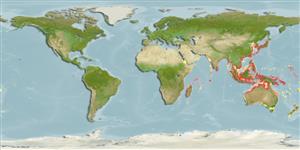Common names from other countries
Environment: milieu / climate zone / depth range / distribution range
Ecología
marino; salobre asociado a arrecife; rango de profundidad 5 - 40 m (Ref. 90102). Tropical
Western Pacific: Gulf of Thailand to southern Japan, Philippines (Ref. 9494), Borneo and Indonesia. Absent from New Guinea and Australia.
Tamaño / Peso / Age
Maturity: Lm ? range ? - ? cm
Max length : 26.0 cm TL macho / no sexado; (Ref. 90102); common length : 16.0 cm TL macho / no sexado; (Ref. 9893); peso máximo publicado: 168.50 g (Ref. 124479)
Radios blandos dorsales (total) : 74 - 78; Radios blandos anales: 65 - 68; Vértebra: 51 - 52.
Inhabits shallow sand and mud bottoms of coastal waters. Feeds mainly on benthic invertebrates, especially small crustaceans. Marketed fresh, frozen, and dried-salted.
Life cycle and mating behavior
Maturities | Reproducción | Spawnings | Egg(s) | Fecundities | Larva
Munroe, T.A., 2001. Soleidae. Soles. p. 3878-3889. In K.E. Carpenter and V. Niem (eds.) FAO species identification guide for fishery purposes. The living marine resources of the Western Central Pacific. Vol. 6. Bony fishes part 4 (Labridae to Latimeriidae), estuarine crocodiles. FAO, Rome. (Ref. 9893)
IUCN Red List Status (Ref. 130435)
CITES (Ref. 128078)
Not Evaluated
Threat to humans
Harmless
Human uses
Pesquerías: comercial
Herramientas
Special reports
Download XML
Fuentes de Internet
Estimates based on models
Preferred temperature (Ref.
115969): 21.3 - 29.1, mean 28.3 (based on 882 cells).
Phylogenetic diversity index (Ref.
82804): PD
50 = 0.5000 [Uniqueness, from 0.5 = low to 2.0 = high].
Bayesian length-weight: a=0.00794 (0.00492 - 0.01282), b=3.10 (2.96 - 3.24), in cm Total Length, based on LWR estimates for this species & (Sub)family-body (Ref.
93245).
Nivel trófico (Ref.
69278): 3.5 ±0.50 se; based on food items.
Resiliencia (Ref.
120179): Medio, población duplicada en un tiempo mínimo de 1.4-4.4 años (Preliminary K or Fecundity.).
Fishing Vulnerability (Ref.
59153): Low vulnerability (16 of 100).
